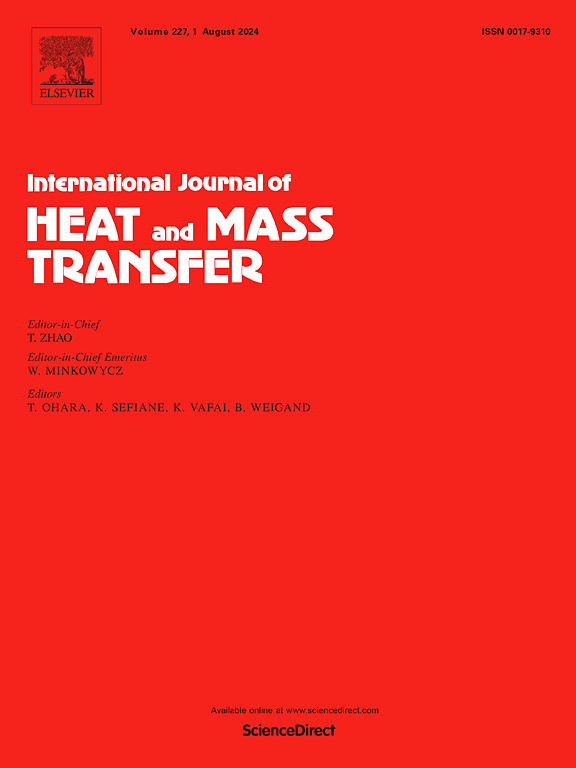MHD stagnation point flow of Casson hybrid nanofluid with bioconvection for biomedical skin patch applications
IF 5.8
2区 工程技术
Q1 ENGINEERING, MECHANICAL
International Journal of Heat and Mass Transfer
Pub Date : 2025-04-03
DOI:10.1016/j.ijheatmasstransfer.2025.127048
引用次数: 0
Abstract
This study investigates the magnetohydrodynamic (MHD) stagnation point flow of a Casson hybrid nanofluid across a stretchable surface, with applications in biomedical fields such as thermal management in skin patches. The research addresses the critical need for efficient heat and mass transfer in medical applications by utilizing a hybrid nanofluid composed of magnesium oxide and silicon dioxide nanoparticles dispersed in blood as the base fluid. These nanoparticles are chosen for their biocompatibility, cost-effectiveness, and ability to enhance heat and mass transfer properties. The study incorporates the CattaneoChristov double diffusion model alongside the bioconvection phenomenon and effects of magnetic strength, thermal radiation, viscous dissipation, and chemical reactions. The governing partial differential equations (PDEs) are transformed into nonlinear ordinary differential equations (ODEs) using similarity transformations and solved numerically using the BVP4C algorithm with a three-stage Lobatto method. The following dimensionless parameter ranges are considered: Casson parameter from 1 to 7, magnetic strength from 0.01 to 0.18, Eckert number from 0.5 to 2, radiation parameter from 0.3 to 1.2, Schmidt number from 1 to 2.5, and chemical reaction parameter from 0.5 to 0.8. Key findings demonstrate that the temperature distribution increases with the , while the velocity profile decreases with higher values. The study also highlights that hybrid nanofluids significantly reduce drag force by 34–39 % for Casson parameter values ( =1, 3, 5). Additionally, the Nusselt number shows a substantial enhancement of 50–72 % for specific ranges of the Brinkman number ( = 1–3) and radiation parameter ( = 0.3–0.9), with a maximum increase of 72.69 %. Response surface methodology and sensitivity analysis are conducted to quantify the sensitivity caused by input data such as the and . The results demonstrate that the coefficient of determination for skin friction coefficient and Nusselt number are 94.75 % and 97.23 %, respectively. This is an indication that we have obtained the best-fit empirical correlations. The sensitivity analysis results showed that the skin friction coefficient and Nusselt number are highly sensitive to the chemical reaction parameter.
生物医学皮肤贴片用卡森混合纳米流体的MHD滞止点流动
本研究研究了Casson混合纳米流体在可拉伸表面上的磁流体动力学(MHD)滞止点流动,并将其应用于生物医学领域,如皮肤贴片的热管理。该研究通过利用分散在血液中的氧化镁(MgO)和二氧化硅(SiO2)纳米颗粒组成的混合纳米流体作为基础流体,解决了医疗应用中高效传热传质的关键需求。选择这些纳米颗粒是因为它们的生物相容性、成本效益和增强传热传质性能的能力。该研究结合了CattaneoChristov双扩散模型以及生物对流现象和磁场强度、热辐射、粘性耗散和化学反应的影响。利用相似变换将控制偏微分方程转化为非线性常微分方程,并采用三阶段Lobatto法对BVP4C算法进行数值求解。考虑以下无量纲参数范围:卡森参数(β)为1 ~ 7,磁场强度(M)为0.01 ~ 0.18,埃克特数(Ec)为0.5 ~ 2,辐射参数(Rd)为0.3 ~ 1.2,施密特数(Sc)为1 ~ 2.5,化学反应参数(κ)为0.5 ~ 0.8。主要研究结果表明,温度分布随Ec增大而增大,而速度分布随β值增大而减小。研究还表明,在Casson参数值(β = 1,3,5)下,混合纳米流体显著降低了34 - 39%的阻力。此外,在Brinkman数(Br =1 - 3)和辐射参数(Rd = 0.3-0.9)的特定范围内,Nusselt数显著提高了50 - 72%,最大增幅为72.69%。采用响应面法和灵敏度分析来量化由输入数据如β、Ec和κ引起的灵敏度。结果表明,表面摩擦系数和努塞尔数的确定系数分别为94.75%和97.23%。这表明我们已经获得了最佳拟合的经验相关性。灵敏度分析结果表明,表面摩擦系数和努塞尔数对化学反应参数高度敏感。
本文章由计算机程序翻译,如有差异,请以英文原文为准。
求助全文
约1分钟内获得全文
求助全文
来源期刊
CiteScore
10.30
自引率
13.50%
发文量
1319
审稿时长
41 days
期刊介绍:
International Journal of Heat and Mass Transfer is the vehicle for the exchange of basic ideas in heat and mass transfer between research workers and engineers throughout the world. It focuses on both analytical and experimental research, with an emphasis on contributions which increase the basic understanding of transfer processes and their application to engineering problems.
Topics include:
-New methods of measuring and/or correlating transport-property data
-Energy engineering
-Environmental applications of heat and/or mass transfer

 求助内容:
求助内容: 应助结果提醒方式:
应助结果提醒方式:


